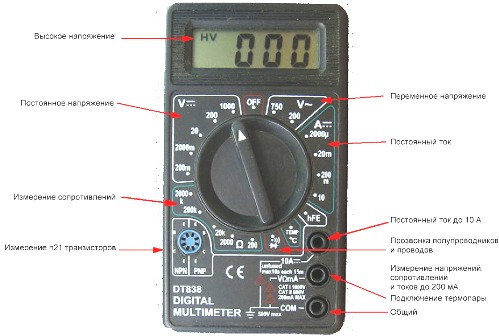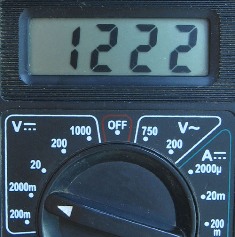Categories: Practical Electronics, Repair of household appliances
Number of views: 57511
Comments on the article: 5
How to use a multimeter, DC voltage measurement
 Word multimeter consists of two words: multi - a lot and meter - measurements, measuring device. These definitions can be found in the multitran English-Russian dictionary, and therefore, with full confidence we can say that a multimeter is a multitude of measuring instruments “packed” in one small box. All these measuring instruments are designed for measurements in electrical circuits, and it would be unforgivable to start a story about electrical measurements without remembering Ohm's law.
Word multimeter consists of two words: multi - a lot and meter - measurements, measuring device. These definitions can be found in the multitran English-Russian dictionary, and therefore, with full confidence we can say that a multimeter is a multitude of measuring instruments “packed” in one small box. All these measuring instruments are designed for measurements in electrical circuits, and it would be unforgivable to start a story about electrical measurements without remembering Ohm's law.
In school textbooks, Ohm's law for a section of a circuit is written as follows: "The current in the circuit (I) is directly proportional to the voltage (U), and inversely proportional to the resistance (R)." All who are seriously engaged in electricity know this phrase as our Father. And then say, not knowing Ohm’s law - sit at home.
If Ohm's law is written in the form of a mathematical formula, it will turn out quite simply: I = U / R.
This is Ohm's law for a section of the chain, which we will limit ourselves to here. To get the correct results, the current values in Amperes, voltages in Volts, and resistance in Ohms should be substituted into the formula. The first letters are uppercase, since the units of measurement came from the names of the scientists who discovered these laws.
True, it is not forbidden to substitute, for example, the resistance in kilo-ohms (1 KΩ = 1000 Ohms), then the current will turn out in milliamperes (1 mA = 0.001 A). Such substitution in low-current circuits is often used.
The simplest electrical circuit shown in Figure 1 consists of a voltage source, connecting wires, circuit breaker and load. But on the example of this circuit you can see everything that is mentioned in Ohm's law, everything that can be measured using instruments, get acquainted with the connection of an ammeter, voltmeter and ohmmeter.
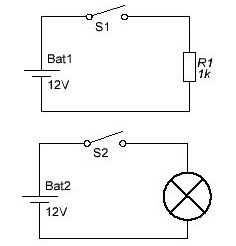
Figure 1. The simplest electrical circuit
For current measurements, stresses and resistance three different devices will be required: an ammeter, a voltmeter, and an ohmmeter. Connecting devices is shown in Figure 2.
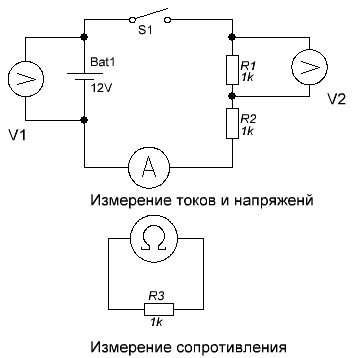
Figure 2. Connecting measuring instruments to an electrical circuit
From this figure it is clear that ammeter it is connected to the circuit break in series with the load, the voltmeter is connected in parallel to the circuit section, the ohmmeter is also parallel to the test section, but the supply voltage must be disconnected, or an unconnected part is checked at all. Of course, you can measure the resistance of the resistors R1, R2, without evaporating them from the circuit, just remember to turn off the power.
What not to do or the right ways to burn a multimeter
Here you can immediately make a few comments, ask a few tricky questions. What will happen if you swap, confuse, for example, a voltmeter and ammeter?
The voltmeter, included in the circuit breaker instead of the ammeter, will most likely not bring any particular troubles: the large internal resistance of the voltmeter will limit the current at such a level that the circuit simply stops working, as if the circuit breaker were opened.
It is quite another matter if the ammeter is switched on in place of a voltmeter, for example, instead of V1. The current through the ammeter will reach the maximum that the power source is capable of supplying, since the internal resistance of the ammeter is very small (in normal measurement mode, the smaller the better).
When galvanic cell this is not particularly scary, since the current will be limited by the internal resistance of the battery, and the measurement limit of the ammeter is quite large (10 or more amperes).
This is how one can test an AA or AAA size cell with a voltage of 1.5V.If the element is serviceable, then the ammeter will show a current of at least 1A, or even more, while the current of the discharged element is not more than a few milliamps or no current at all.
But such a recommendation is absolutely unsuitable for checking batteries of the same size: batteries really do not like short circuits, and can even explode! Even if it doesn’t reach the explosion, charging such a battery will be problematic.
If the ammeter (multimeter in current measurement mode) is "plugged" into a 220V outlet, then the explosion of the device is simply inevitable. The same thing happens if you try to measure the voltage in the outlet with a multimeter in the resistance measurement mode. Believe me, there have been many such cases. That is why it is not necessary, when it is not necessary, purely out of interest, to measure the voltage at the outlet!
It just needs to be accepted as a law, taken as a rule. Well, what's the difference, how many are 210 or 235V in this outlet? Indeed, all modern electronic equipment operates in a very wide voltage range, which is facilitated by modern switching power supplies.
Many instruments for simple measurements
The electric circuit shown in Figure 2 is powered by a direct current source - a galvanic battery, so the ammeter and voltmeter should be designed for measurement in DC circuits. If even such a simple circuit is powered by alternating current (220V, circuit breaker, light bulb), then the devices will require alternating current. It turns out that you need a whole bunch of devices, even with such a simple scheme!
This simple circuit is shown in order to refresh the ways of connecting devices in memory. More details about measuring currents and voltages can be found in the article. "Measurements in electrical circuits".
It is very simple to get rid of such a number of devices: assemble all devices in one housing and use the switches to connect the same measuring arrowhead to each of them. Such devices were once called combination or avometers - AmpereVoltOmmeter.
Another name for these devices is a tester, from the English test - verification, test, since the accuracy of measurements with such devices is small. As a rule, these are devices of the 4th accuracy class, i.e. the measurement error is 4%, which is quite enough for most practical purposes.
At present, arrow testers, not only retired, but rarely used, although in some cases, they simply can not do without. But many, mostly old specialists, prefer to use arrow gauges. Well, this is who is used to what. So, slowly, we came to a modern combined instrument - a multimeter.
Modern digital multimeter
Unlike antique testers, the multimeter has become a digital device, and the Digital Multimeter is written on the packaging box. This is not from the fact that the readings are displayed in the form of numbers, the difference lies in the principle of operation. The measured value, voltage, current or resistance using an analog-to-digital Converter (ADC) is converted into a digital code, which is then displayed on a digital liquid crystal display.
In addition to the actual measurement results, the indicator may show additional information: the state of the battery charge (when it is time to change the battery, a blinking image of the battery appears on the display) and a warning about measuring high voltages. Multimeters, with small dimensions and low prices, have high measurement accuracy, which provided them with well-deserved popularity among users.
The easiest way to deal with the device and the operation of the device when it is in the hands. But, since there is no such possibility, then a picture with the image of the device is quite suitable. It is enough to take a photograph and provide it with explanatory inscriptions. A similar photograph is shown in Figure 3. (click on the picture to enlarge).
Figure 3The appearance of the digital multimeter D838
Why and who needs a multimeter
Multimeters of the D83X series are a budget option - at a minimum cost there is a set of all, or almost all, of the operating modes that most electricians, electronic engineers and just those who have to communicate with electricity from time to time use. Of course, there are more expensive models that have additional measurement limits and various operational amenities.
First of all, it is the ability to measure capacitance of capacitors and inductance of coils. Some multimeters even have a frequency measurement mode, however, it is usually limited to the frequencies of the audio range, up to 20KHz. Almost all multimeters, including the budget option, have a mode for measuring the gain of low-power transistors, but they are not used very often.
Additional options include the backlight of the scale (how else to take measurements at night?) And the button for saving the last measurement result. Such memorization makes it possible to write the result in a notebook or in a pre-printed table. Actually, a very useful property.
The DT838 multimeter shown in Figure 3 as a pleasant addition has a temperature measurement mode: if you simply turn on the multimeter in this mode, then using the internal temperature sensor you can monitor the temperature in the working room.
The device is completed external thermocouple type K, which allows you to measure temperatures up to several hundred degrees, for example, the temperature of a soldering iron or hot air gun.
Similar devices of other series, for example, DT832, instead of a temperature meter, have a built-in rectangular pulse generator with a fixed frequency of about 1 KHz, which allows you to check, for example, audio frequency amplifiers.
Do not forget to turn off the multimeter at night
Another of the nice features inherent in more expensive multimeters is the automatic power off: after 15 minutes, the device turns off. Further work is possible only by pressing the power button again.
In devices like the D83x, shutdown is done by setting a single switch to the OFF position (see Fig. 3). If you get carried away very much and forget to turn off the device, leave it overnight (for some reason this happens most often), then the battery will have to be changed the next day.
The cost of the “Krona” battery (the old domestic name, now it's just type 6F22) is of average quality is small, and buying it is not a problem. But, nevertheless, even in one of the latest Radio magazines for 2014, namely, in issue 9, an article appeared entitled "Converter for powering a digital multimeter."
The converter runs on a single AA-size battery or on a single nickel-cadmium battery. A simple circuit, a printed circuit board, and assembly and configuration techniques are also given there. At the end of the article, a list of several earlier publications on this topic is given: also Radio magazines with similar schemes.
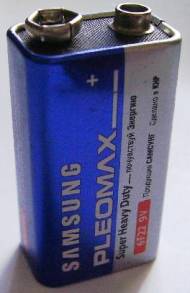
Figure 4. Imported “Krone”
Such a design was appropriate during the Soviet general shortage, when it was impossible to "get" the Kron battery, like so much more. Now such a converter can only be assembled “out of love of art”.
In general, the editors of Radio magazine in recent years have behaved very strangely: instead of publishing good, interesting materials, improving the quality of publications, they (the editors) are chasing file sharing services and seizing from there their creations under the brand name of copyright protection law.
Let the reader not think that this is the subjective opinion of the author of the article about the journal: on electronic forums, you can find plenty of reasoning on this subject, much more categorical.
Let's start studying the multimeter
Often you hear such statements: “Well, I know how to ring a wire from an electric guitar for an open or short circuit. And I don’t need another. ”To make such statements smaller, let us once again turn to Figure 3, which will help to figure out what the multimeter can measure.
On the front panel of the multimeter, two large details are immediately evident: on top is a liquid crystal indicator (display), and in the middle is a large round control knob. In this device, it is, in fact, the only one, there are simply no others. It is with this handle that the operation modes and measurement limits are switched in these modes. Multimeters of other brands look about the same.
To indicate the selected measurement limit, the handle has a bevel with an extruded triangle, which is not very convenient when working. If this triangle is filled with white paint, as shown in Figure 3, then there will be much less erroneous inclusions.
Measurement Modes
Using the just mentioned knob, you can select one of the measurement modes. The considered multimeter provides several MODES:
-
DC voltage measurement
-
AC voltage measurement
-
DC current measurement
-
Resistance measurement
-
Wiring of wires and semiconductors
-
Transistor Gain Measurement
-
Temperature measurement
Each measurement mode, in addition to measuring temperature, semiconductor continuity and transistor gain, is divided into several LIMITS, which can significantly increase the accuracy of measurements, which will be described later.
In practical work, most often it is necessary to measure constant voltages and use the “dialing” mode to determine the integrity of the installation or the health of diodes, transistors, sometimes even microcircuits. Therefore, these measurements will have to be described in sufficient detail.
DC voltage measurement
Electronic equipment is powered by constant voltage sources. These can be batteries, galvanic cells, and when powered from the mains, these are power supplies of various circuits and designs. Therefore, in the repair and commissioning of electronic equipment, most often it is necessary to measure the constant voltage on the electrodes of transistors and microcircuits, to check the operating modes for direct current. How to use a multimeter to measure DC voltages is described further.
In Figure 3, the switch of the kind of work is set to the constant voltage measurement mode, and, to the highest limit, up to 1000V. At the same time, the display shows a warning about the danger of high voltage: HV - (high voltage - high voltage). The same warning will appear on the 750V AC limit. Thus, the device itself warns that life-threatening voltages may be present in this measurement range.
But this is not necessary at all, since at this limit it is possible to measure voltages that are not at all dangerous, for example, in automotive wiring, where the voltage is only 12V, or just a single galvanic cell. True, the measurement results will not be very accurate. More reliable results will be obtained when measuring at a limit of 20V.
When digital instruments were rare, they were mainly huge laboratory instruments “with two handles for carrying”, almost all measurements were carried out with arrow meters. And then there was such a rule that the most accurate result would be obtained if in the process of measuring the arrow is not lower than the first third of the scale, it is better if closer to the middle. For example, the voltage of 5V can be measured at the limit of 30V, but the result will be more accurate if you use the limit of 10V.
This recommendation should be followed when working with a digital multimeter, i.e. choose the most suitable measurement limit. This will be discussed later.
DC voltage measurement limits
There are five LIMITS in the DC voltage measurement MODE:
-
200m
-
2000m
-
20,
-
200,
-
1000.
At a limit of 200m (hereinafter, as it is written on the device in Fig. 3), it is possible to measure voltages not exceeding 200 millivolts, to put it more simply, only 0.2V.
The 2000m limit allows you to measure voltage up to 2V. For example, this allows you to measure the voltage of a galvanic cell or the voltage drop across a resistor in the emitter circuit of a transistor.
The following three limits are simply indicated by numbers without letters: 20, 200, 1000. These are voltages of the measurement limits in Volts. Reasoning about the accuracy of measurements can confirm the figures shown below. The AA size finger-type battery was taken as the source of the measured voltage, just the first thing that came to hand, but the measurement results turned out to be quite clear.
Measurements at different limits
The first measurement of the battery voltage was performed at the limit of 1000, as shown in Figure 5. It should be noted that insignificant zeros do not cancel out at all limits.
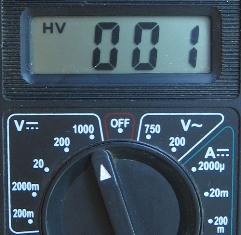
Figure 5
Here it was possible to measure exactly 1B, since the resolution of this limit is just 1B, tenths of a volt simply are not shown, which is indicated by the absence of a comma after the least significant sign. If the measured voltage is, for example, 135.2V, then we could see the result of 135V.
Maybe someone will say: “Think, two tenths of a volt!”. Yes, in the second case, these two tenths do not play any role at all, but when measuring the voltage on the battery, such rounding of the measurement result is unacceptable.
The fact is that a nickel-cadmium or metal hydride battery is considered charged if the voltage on it is not less than 1.2V. If the voltage is only 1V, then this indicates that the battery needs recharging. But it was he who just fell under the arm, although he was not guilty of anything.
Switch the voltage measurement limit to 200. A decimal point already appears, after which tenths of a volt will be displayed. The measurement result is much closer to the truth, which can be seen in Figure 6.
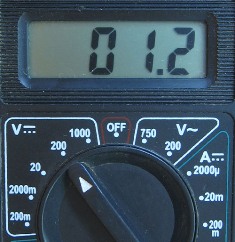
Figure 6. Battery voltage 1.2 V
At the measurement limit of 20, the result will be more accurate, up to hundredths of a volt, look at Figure 7.
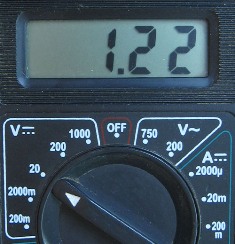
Figure 7. Battery voltage 1.22 V
And at the limit of 2000m, the result is shown in millivolts, i.e. accurate to 1/1000 volts (1 millivolt). Shown in Figure 8.
Figure 8. Battery voltage 1.222 V
Some devices have a measurement limit of 2 (2 volts), then the result will look like 1.222V. There are three digits after the decimal point, which also allows measurements with a resolution of 1 millivolt.
The limit of 200m allows you to measure voltages not higher than 0.2V and for the case in question (battery) it does not fit, it’s just too small. The device may not burn out, but this should not be done. In general, there is such a GOLDEN rule: if the magnitude of the measured voltage (current) is unknown at least approximately, then measurements should start from the largest measurement limit!
Continuation of the article:How to measure voltage, current, resistance with a multimeter, check diodes and transistors
Boris Aladyshkin
See also at i.electricianexp.com
:

